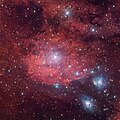| Alternative names | LBN |
|---|---|
| Survey type | Nebula Catalog (excluding dark nebulae) |
| Named after | Beverly Lynds |
| Wavelength | visible light |
| | |
Lynds' Catalogue of Bright Nebulae (abbreviation: LBN) is an astronomical catalogue of bright nebulae.
Contents
Objects listed in the catalogue are numbered with the prefix LBN (not to be confused with LDN, or Lynds' Catalogue of Dark Nebulae). Many entries in the catalogue also have other designations; for example, LBN 974, the Orion Nebula is also known as M 42 and NGC 1976.
It was originally compiled in the 1960s by Beverly Lynds. [1] Objects in the catalogue include (among other things) the coordinates of nebulae, brightness from 1 to 6 (with 1 being the brightest and 6 being barely detectable), colour and size and cross-references to other astronomical catalogues if listed elsewhere. [2] In total, the catalog contains 1125 items. [3]


























